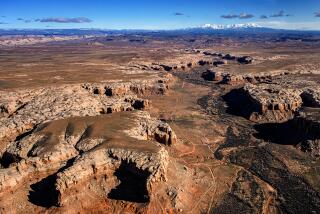Ranchers See Rare Orchid as a Threat to Livelihood
- Share via
SHEYENNE NATIONAL GRASSLANDS, N.D. — An elegant orchid is at home on the range in subzero winters and scorching summers, but it has not been able to tolerate civilization.
At one time the Western prairie fringed orchid flourished from Oklahoma into Canada, producing pale green blooms with wispy white beards.
Today, only three concentrations are known: One on the Sheyenne National Grasslands 50 miles southwest of Fargo in southeastern North Dakota, one in northwestern Minnesota and a recently discovered group in southern Manitoba.
Federal protection for the three-foot-tall plant could endanger the livelihoods of 76 ranchers who graze cattle on the Sheyenne.
The orchid and a diminutive cousin, the Eastern prairie fringed orchid, were listed as threatened under the Endangered Species Act in 1989. The orchid’s perilous position is directly linked to the destruction of the Western tall-grass prairie by the plow, said Larry Potts, chief ranger on the Sheyenne grasslands.
There were roughly 240 million acres of distinctive tall-grass prairie when European settlers arrived in the late 1800s. Most scientists agree that less than 1% is left. Even the federal grassland is not native prairie; much of it was farmed or ranched until individual owners gave up their land in the Depression and Dust Bowl years.
But cattlemen who lease pasture on the Sheyenne oppose protection for the orchid. Lynn Wolf, secretary of the Sheyenne Valley Grazing Assn., says the cattlemen are paying the price for past farming practices.
“We’ve become guinea pigs,” Wolf said. “Even though we haven’t harmed the plant, we have to change our management practices.”
A management plan for the Sheyenne’s 71,000 acres, where the 76 ranchers graze about 10,000 head of cattle, is still being written.
Biologist Jack Challey, a consultant to the North Dakota Natural Heritage program, said ranchers simply refuse to believe the orchid is rare.
“They’ve seen it all their lives,” Challey said. “What they don’t see is the nationwide perspective, and I guess they don’t care to.”
Since 1987, Forest Service biologists have been monitoring 160 of the orchids on the Sheyenne National Grasslands.
Researchers have returned year after year to monitor what is left of those original plants and to mark new ones.
Only 55% of the 160 sample orchids marked during the first year of the study were found a year later, said researcher Carolyn Sieg. By 1991, there were 11%, although this year above-ground growth was found in 13%.
Potts said researchers do not know if individual plants have died or just gone dormant.
Ranchers say the decline was a reflection of four years of drought. Rainfall finally returned last year.
“This year we’ve got orchids in places we’ve never had them before,” Wolf said. “If we have another wet year, next spring we’re going to have orchids running out of our ears.”
Another problem is an aggressive weed called leafy spurge, which crowds out the orchid and plants that cattle prefer. “There are herbicides used to set it back, but we don’t know their effect on the orchid,” Sieg said.
A final report on the orchid is about six months away, Sieg said. Custer National Forest planner Leroy White said he expects it will mean some changes in the number of grazing permits as well as restrictions on herbicides.
Cattlemen fear that the federal grazing land they count on will be turned into orchid preserves.
“I think if we take cows out of that area, we’re just asking to be eliminated,” Wolf said.
Potts said their concern is natural.
“They look at what happened in the Pacific Northwest with the spotted owl and the ancient forest,” he said. “The Forest Service and the Bureau of Land Management were brought to their knees because of one bird.
“I think a lot of ranchers are looking at something like that happening here.”
More to Read
Sign up for Essential California
The most important California stories and recommendations in your inbox every morning.
You may occasionally receive promotional content from the Los Angeles Times.













